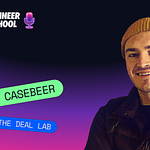Brought to you by
This could be your logo!
Reach out to Jared to sponsor the next episode of this podcast and reach 4000+ modern GTM operator and founders.
About our guest — Nico Druelle
Nico Druelle is the founder of The Revenue Architects, a consultancy that helps B2B SaaS companies build and scale their revenue engines. He is a leading voice in the GTM engineering community, recognized for his early advocacy of the role and his expertise in building signal-driven GTM motions for companies like Attention, Descript, and Preply. Before launching The Revenue Architects, he led GTM ops at Melio, scaling pipeline with advanced workflow tools.
Core takeaways
The Evolution of Rev Ops: GTM engineering is a consolidation of skills from traditional Rev Ops, Marketing Ops, and data engineering. The modern GTM engineer is an architect, a data expert, and an executor, all in one.
The Power of Consolidation: A single GTM engineer can replace a team of specialists, leading to increased speed, efficiency, and ROI. This consolidation reduces friction and allows for faster iteration and validation of growth experiments.
The Modern GTM Stack: The core components of a modern GTM stack include a data layer (data warehouse), an orchestration layer (Clay, Cargo), an engagement layer (Unify), and a CRM (Salesforce).
The Scarcest Resource: The ability to set up and iterate on a holistic GTM system is the most valuable and scarce resource, not the data or the tools themselves.
Top quotes
On GTM engineering: “Go-to-market engineering is a discipline of orchestrating first party data and third party data into a system of action, system of engagement to execute a given vision, a given go-to-market strategy.”
On the GTM engineer’s role: “He’s that glue that comes in, just runs experiments, know, test things out, get some results filled back from the market and keep on iterating. And ultimately the uniqueness of that position is that he generates pipeline.”
On the evolution from Rev Ops: “If rev ops was the before and go to market is the now or after, I think there is a bit of a consolidation of function of skills.”
On the value of a GTM engineer: “The scarce resource is basically the ability to set up that system altogether as a holistic solution and iterate on it to build a defensible system to design growth. That is the real value in this.”
Referenced tools and resources
CRM: Salesforce
LLM: OpenAI (ChatGPT), Claude
Enrichment & Orchestration: Clay, Cargo
Engagement: Unify
Workflow Automation: N8N
Timestamps
(02:13) Nico’s definition of GTM engineering
(03:58) The before and after of GTM engineering
(06:24) The GTM engineer as an architect, plumber, and electrician
(08:19) Why the GTM engineer role is a consolidation of multiple roles
(09:45) The benefits of consolidation: speed and less friction
(12:10) Lightning Round: Favorite CRM (Salesforce)
(14:18) Lightning Round: Top LLM (OpenAI/ChatGPT)
(16:19) Lightning Round: Top enrichment tools (Cargo and Clay)
(17:23) Nico’s top GTM engineering tools (Unify)
(19:16) The core building blocks of Nico’s GTM stack
(23:12) The role of a tool like Default for PLG companies
(24:25) Tradeoffs in designing GTM stacks: modularity vs. speed
(27:13) A deep dive into a PQL nurturing flow built for Descript
(31:26) The importance of evaluations (evals) in AI model performance
(37:53) Essential skills for aspiring GTM engineers: data literacy, tool fluency, and business acumen
(40:10) How to acquire GTM engineering skills
(42:14) The importance of feature engineeringHow to connect with Nico
Where to find Nico
Where to connect with Jared & Matteo
Jared Waxman, GTM Engineer School Co-founder: LinkedIn
Matteo Tittarelli, GTM Engineer School Co-founder: LinkedIn, X, Website, Newsletter













